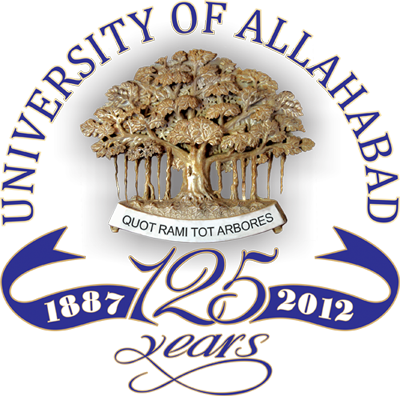AU INTRO
| University of Allahabad The Face-to-Face L4C WORKSHOP | Introduction | Objectives | Workshop Schedule | Participants | Report | 5 to 7 March, 2014 |
UNIVERSITY OF ALLAHABAD
Allahabad University has always occupied an esteemed place among the universities of India for over a century now. Established on 23rd September 1887, it is the fourth oldest university of India after Calcutta, Bombay and Madras University.The credit for conceiving a large Central College at Allahabad, eventually to develop into a University, is due to Sir William Muir, then Lt. Governor of United Provinces. As a result of his initiative the foundation stone of the Muir Central College (named after him) was laid on Dec. 9 1873 by His Excellency Lord Northbrook. Sir William Muir said on that occasion: "The establishment of a central college at Allahabad has been my earnest desire ever since I assumed my present office. Shortly after coming here I found that a strong wish prevailed among the chief people of the place for a better means of education at Allahabad; and being myself deeply impressed with the same conviction, I took occasion at the first Darbar which I held here to urge upon those present the necessity of showing that they were sincere and in earnest, by contributing to the work. The appeal was widely and liberally met, a considerable sum was subscribed and address was presented to me in 1869, praying for the establishment of the college here."
AIM OF THE WORKSHOP
The Internet has become an increasingly important feature of the learning environment. Over time, the users of the Internet and World Wide Web have benefited from the big improvements in their ability to learn and the way they pursue their academic interests. A majority of the Internet users also consistently report that it helps them to do their job better and improves the way they get information about anything using internet search engines and the websites like Wikipedia. The quest for knowledge in Internet has also led to the development of the free teaching, learning and research resources known as open educational resources that reside in the public domain and can be accessed by anyone and at anytime free of cost.
This workshop, supported by CEMCA, was aimed at building capacity in the area of Open Educational Resources by imparting training to educators, teachers and trainers who share the vision for free educational resources. The objective of this workshop was to provide practical hands-on skills that are essential in creating such collaborative environment where content evolves through the efforts and contributions of a large community of practitioners, researchers, learners, experts and teachers of Humanities, Social Sciences, Sciences & Engineering, whose shared goal is to make the information accessible to all.


